Do you have a question about the Komatsu PC210 and is the answer not in the manual?
Explains the meaning of safety warning symbols and text.
Covers safety checks, fire prevention, and cab conditions before starting the engine.
Details checks and procedures for starting and operating the machine safely.
Covers safety precautions, proper tools, and periodic replacement of critical parts.
Outlines safety procedures for personnel, attachments, and working under the machine.
Details the function and display of the machine's monitor panel and warning lamps.
Lists emergency stop items that require immediate attention and operation stoppage.
Details the safety lock lever, travel levers, and work equipment control levers.
Explains accumulator safety precautions and dangerous handling risks.
Guides a systematic visual inspection of the machine before starting the engine.
Details the procedure for checking and adding coolant to the radiator reserve tank.
Explains how to check and add engine oil using the dipstick and oil filler.
Covers operations and checks required before starting the engine.
Provides instructions for starting the engine under normal and cold weather conditions.
Outlines normal warming-up operations and checks after starting the engine.
Details steps for safely moving the machine forward and backward, including checks.
Explains how to change direction using travel levers for stopped and moving machines.
Provides guidelines and precautions for safely stopping the machine.
Details the procedure for operating the swing function, including lock switch usage.
Explains the operation of work equipment using control levers and auto-deceleration.
Explains how to use the active mode for efficient digging, loading, and leveling operations.
Guides on selecting working modes (H.O., G.O., F.O., L.O., B.O.) for efficient operation.
Details prohibited operations to ensure machine longevity and operator safety.
Provides general precautions for machine operation, including travelling and water depth.
Details precautions for travelling on slopes, including speed, posture, and turning.
Provides procedures to free the machine when stuck in mud, based on side conditions.
Provides guidelines and precautions for safely parking the machine.
Outlines checks to perform on the machine after completing work.
Provides instructions for stopping the engine correctly to prevent damage.
Outlines checks to perform on the machine after stopping the engine.
Covers crucial safety precautions for loading and unloading the machine.
Explains the correct method and precautions for towing the machine.
Offers guidance on handling the battery and procedures for starting with booster cables.
Details precautions for connecting and disconnecting booster cables for engine starting.
Lists common problems and their causes/remedies across electrical, chassis, and engine systems.
Details the maintenance schedule for initial, periodic, and required service intervals.
Outlines maintenance tasks to be performed after the first 250 hours of operation.
Covers checks, cleaning, and replacement of the air cleaner element.
Provides instructions for cleaning the cooling system, including antifreeze mixing rates.
Explains how to check and adjust track tension for optimal performance.
Covers checks required before starting the engine, including fluids and wiring.
Discusses safety implications of using non-authorized attachments and precautions for removal/installation.
Highlights dangers of long work equipment affecting stability and proper installation procedures.
Explains the meaning of safety warning symbols and text.
Covers safety checks, fire prevention, and cab conditions before starting the engine.
Details checks and procedures for starting and operating the machine safely.
Covers safety precautions, proper tools, and periodic replacement of critical parts.
Outlines safety procedures for personnel, attachments, and working under the machine.
Details the function and display of the machine's monitor panel and warning lamps.
Lists emergency stop items that require immediate attention and operation stoppage.
Details the safety lock lever, travel levers, and work equipment control levers.
Explains accumulator safety precautions and dangerous handling risks.
Guides a systematic visual inspection of the machine before starting the engine.
Details the procedure for checking and adding coolant to the radiator reserve tank.
Explains how to check and add engine oil using the dipstick and oil filler.
Covers operations and checks required before starting the engine.
Provides instructions for starting the engine under normal and cold weather conditions.
Outlines normal warming-up operations and checks after starting the engine.
Details steps for safely moving the machine forward and backward, including checks.
Explains how to change direction using travel levers for stopped and moving machines.
Provides guidelines and precautions for safely stopping the machine.
Details the procedure for operating the swing function, including lock switch usage.
Explains the operation of work equipment using control levers and auto-deceleration.
Explains how to use the active mode for efficient digging, loading, and leveling operations.
Guides on selecting working modes (H.O., G.O., F.O., L.O., B.O.) for efficient operation.
Details prohibited operations to ensure machine longevity and operator safety.
Provides general precautions for machine operation, including travelling and water depth.
Details precautions for travelling on slopes, including speed, posture, and turning.
Provides procedures to free the machine when stuck in mud, based on side conditions.
Provides guidelines and precautions for safely parking the machine.
Outlines checks to perform on the machine after completing work.
Provides instructions for stopping the engine correctly to prevent damage.
Outlines checks to perform on the machine after stopping the engine.
Covers crucial safety precautions for loading and unloading the machine.
Explains the correct method and precautions for towing the machine.
Offers guidance on handling the battery and procedures for starting with booster cables.
Details precautions for connecting and disconnecting booster cables for engine starting.
Lists common problems and their causes/remedies across electrical, chassis, and engine systems.
Details the maintenance schedule for initial, periodic, and required service intervals.
Outlines maintenance tasks to be performed after the first 250 hours of operation.
Covers checks, cleaning, and replacement of the air cleaner element.
Provides instructions for cleaning the cooling system, including antifreeze mixing rates.
Explains how to check and adjust track tension for optimal performance.
Covers checks required before starting the engine, including fluids and wiring.
Discusses safety implications of using non-authorized attachments and precautions for removal/installation.
Highlights dangers of long work equipment affecting stability and proper installation procedures.
| Bucket Capacity | 0.8 - 1.2 m³ |
|---|---|
| Travel Speed | 5.5 km/h |
| Max Digging Depth | 6, 620 mm |
| Max Reach | 9, 850 mm |
| Fuel Tank Capacity | 400 l |
| Engine Model | Komatsu SAA6D107E-1 |
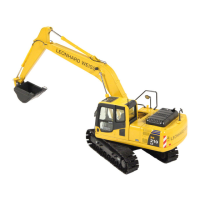
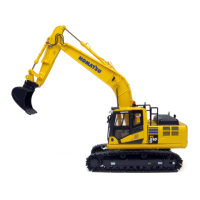


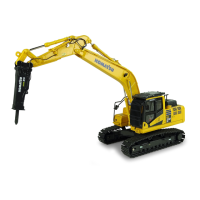

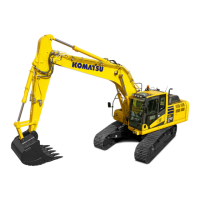

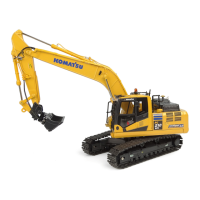

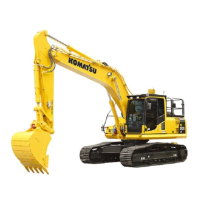

